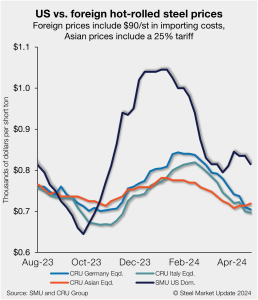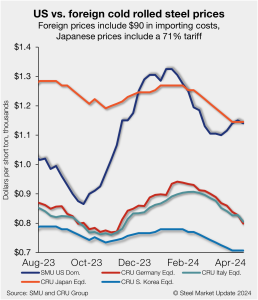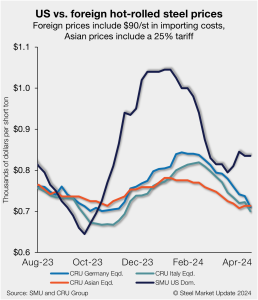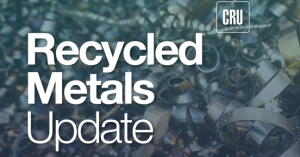GrafTech continues to bleed red on weak demand
GrafTech is reporting weak near-term demand for graphite electrodes as economic uncertainty constrains steel production globally.
GrafTech is reporting weak near-term demand for graphite electrodes as economic uncertainty constrains steel production globally.
Cleveland-Cliffs said its base spot hot-rolled (HR) coil price will be $850 per short ton (st) with the opening of its June order book. The company made the announcement in a press release and in a letter to customers on Friday.

Hot-rolled coil and plate lead times contracted this week, with most other products remaining flat, according to SMU's most recent survey data. Cold-rolled products, however, saw lead times extend 0.1 weeks to an average of 7.5 weeks vs. two weeks earlier. Hot rolled and plate lead times both contracted 0.3 weeks from our last market check.
I’ve gotten some questions lately about whether the huge gap between domestic hot-rolled coil (HR) prices and those for cold-rolled (CR) and coated is sustainable. I remember being asked similar questions about the wide spread between HR and plate that developed in early 2022. I thought at the time that there was no way that spread could hold. Turned out, I was wrong. That was humbling. And so I’m not going to make any bold predictions this time.
Reliance Inc.’s earnings slumped in the first quarter of 2024, but the company expects better than normal seasonal recovery in demand in the second quarter.

Sheet steel buyers said mills are more willing to talk price on spot orders, according to our most recent survey data.
Destocking at service centers and a downturn in steel pricing impacted Ternium’s shipments in Mexico in the first quarter of the year.

US hot-rolled (HR) coil remains more expensive than offshore hot band, though with a tighter premium as prices stateside and abroad have ticked lower in recent weeks.
Steel Dynamics Inc. (SDI) executives said the company's Sinton, Texas, sheet mill should be able to increase melt capacity after an outage earlier this month. Sinton should see "additional improvements in production" after taking "several maintenance days in April," Barry Schneider, SDI president and COO, said in a Q1 earnings conference call on Wednesday.
Lower demand and prices for steel plate impacted SSAB Americas’ results in the first quarter, Swedish parent company SSAB said in its Q1'24 interim report.
We've used the word "unprecedented" a lot over the last four years to describe steel price volatility. Over the last two months – despite earlier predictions of a price surge - we've seen unprecedented stability.
With strength in the sector and customers needing the product it produces, Cleveland-Cliffs’ chief executive says the company will be more selective with the automotive customers it chooses to serve.
Steel Dynamics Inc.'s (SDI's) earnings fell in the first quarter of 2024 as the company cited steel order volatility early in the quarter and lower scrap prices.

Sheet prices were again mixed this week – all seemed to highlight the momentum shift seen over the past two weeks.
Nucor executives explained their recently introduced hot-rolled (HR) coil consumer spot price (CSP) is a way to serve their customers and deal with market volatility.
Galvanized buyers reported steady demand and ample supply this week as pricing momentum has shifted, potentially pointing down. Service centers, distributors, and manufacturers who are members of the Heating, Air-Conditioning & Refrigeration Distributors International (HARDI) association met virtually on Tuesday, April 23, for the monthly meeting of HARDI’s Sheet Metal/Air Handling Council. Sentiment was noticeably […]
Nucor is holding its hot-rolled (HR) coil consumer spot price (CSP) flat this week.
Steel sheet prices in many regions of the world were steady week over week in the week ended April 17.

Foreign cold-rolled (CR) coil remains less expensive than domestic product, according to SMU’s latest check of the market.
Here’s a roundup of the latest news in the global aluminum market from our colleagues at CRU. Biden calls for tripling of Chinese steel and aluminum tariffs President Joe Biden is calling on the US Trade Representative (USTR) to consider increasing the existing section 301 import duty on Chinese steel and aluminum three-fold. The current […]
To the surprise of many — myself included — flat-rolled steel prices appear to be in a holding pattern… again. This is not familiar territory for hot-rolled (HR) coil, at least not over the past few years. Its pricing volatility (as my colleague Michael Cowden has noted in past columns) may rival the elastic moves […]

US hot-rolled (HR) coil has become gradually more expensive than offshore hot band in recent weeks, as stateside prices have stabilized while imports moved lower.

Earlier this week, SMU polled steel buyers on an array of topics, ranging from market prices, demand, and inventories to imports and evolving market chatter.

Sheet prices varied this week. While hot-rolled (HR) coil pricing was largely flat, cold-rolled (CR) coil and tandem product pricing eased slightly reflecting the momentum shift seen last week for HR coil. SMU’s average HR coil price was flat from last week at $835 per short ton (st) – potentially emphasizing the tension between competing […]

Does the price of ferrous scrap depend on the price of finished steel product? And how much of an influence do billet and slab prices have on scrap prices?
Nucor said its spot hot-rolled (HR) coil price for the week of April 15 will be $835 per short ton (st), up $5/st from last week. The Charlotte, N.C.-based steelmaker said the new price would be effective immediately in a letter to customers on Monday morning. The exception again is California Steel Industries (CSI), Nucor’s […]

As the ISRI 2024 conference unfolds in Las Vegas, attendees are diving into crucial discussions shaping the future of the recycling industry. Here are the main topics being discussed: New steelmaking capacity coming online this year Export demand during this period Infrastructure spending Supply of pig iron and HBI Current logistics challenges May scrap prices […]
Last week was a newsy one for the US sheet market. Nucor’s announcement that it would publish a weekly HR spot price was the talk of the town – whether that was in chatter among colleagues, at the Boy Scouts of America Metals Industry dinner, or in SMU’s latest market survey. Some think that it could Nucor's spot HR price could bring stability to notoriously volatile US sheet prices, according to SMU's latest steel market survey. Others think it’s too early to gauge its impact. And still others said they were leery of any attempt by producers to control prices.

The Department of Commerce (DOC) has issued new rules to combat evolving "unfair" trade practice — including the unfair trade of steel products. They go into effect on Wednesday, April 24.
The latest SMU market survey results are now available on our website to all premium members. After logging in at steelmarketupdate.com, visit the pricing and analysis tab and look under the “survey results” section for “latest survey results.” Historical survey results are also available under that selection. If you need help accessing the survey results, or if […]